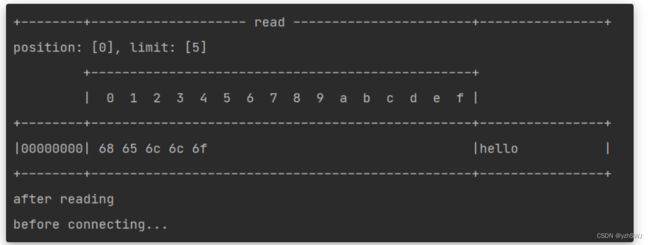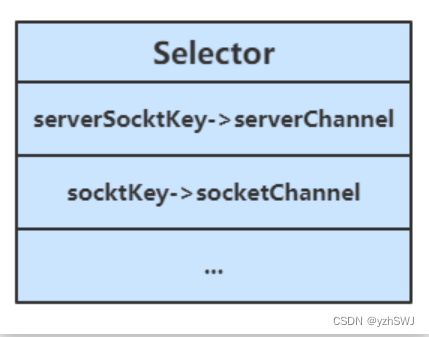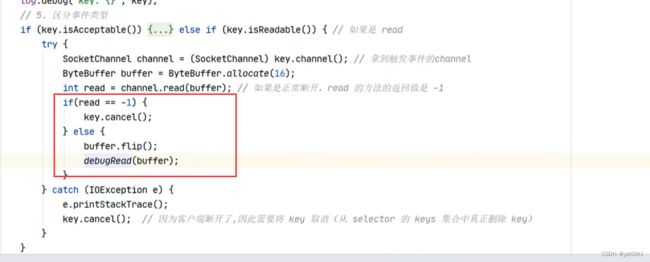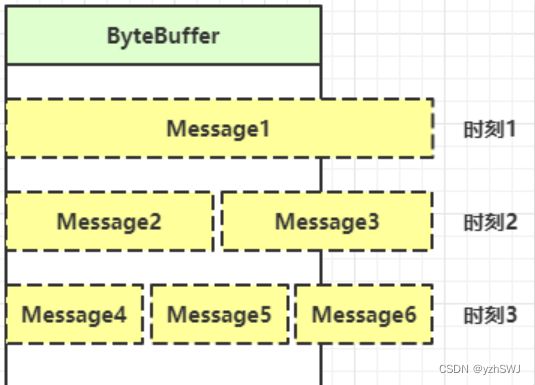NIO网络编程
Netty学习之NIO基础 - Nyima's Blog
1、阻塞
- 阻塞模式下,相关方法都会导致线程暂停
- ServerSocketChannel.accept 会在没有连接建立时让线程暂停
- SocketChannel.read 会在通道中没有数据可读时让线程暂停
- 阻塞的表现其实就是线程暂停了,暂停期间不会占用 cpu,但线程相当于闲置
- 单线程下,阻塞方法之间相互影响,几乎不能正常工作,需要多线程支持
- 但多线程下,有新的问题,体现在以下方面
- 32 位 jvm 一个线程 320k,64 位 jvm 一个线程 1024k,如果连接数过多,必然导致 OOM,并且线程太多,反而会因为频繁上下文切换导致性能降低
- 可以采用线程池技术来减少线程数和线程上下文切换,但治标不治本,如果有很多连接建立,但长时间 inactive,会阻塞线程池中所有线程,因此不适合长连接,只适合短连接
服务端代码
public class Server {
public static void main(String[] args) {
// 创建缓冲区
ByteBuffer buffer = ByteBuffer.allocate(16);
// 获得服务器通道
try(ServerSocketChannel server = ServerSocketChannel.open()) {
// 为服务器通道绑定端口
server.bind(new InetSocketAddress(8080));
// 用户存放连接的集合
ArrayList channels = new ArrayList<>();
// 循环接收连接
while (true) {
System.out.println("before connecting...");
//建立与客户端连接, SocketChannel 与客户端进行通信
//没有连接时,会阻塞线程
SocketChannel socketChannel = server.accept();
System.out.println("after connecting...");
channels.add(socketChannel);
// 循环遍历集合中的连接
for(SocketChannel channel : channels) {
System.out.println("before reading");
// 接/处理通道中的数据
// 当通道中没有数据可读时,会阻塞线程
channel.read(buffer);
buffer.flip();
//调试打印出来
ByteBufferUtil.debugRead(buffer);
buffer.clear();
System.out.println("after reading");
}
}
} catch (IOException e) {
e.printStackTrace();
}
}
} 客户端代码
public class Client {
public static void main(String[] args) {
try (SocketChannel socketChannel = SocketChannel.open()) {
// 建立连接
socketChannel.connect(new InetSocketAddress("localhost", 8080));
System.out.println("waiting...");
} catch (IOException e) {
e.printStackTrace();
}
}
}运行结果
- 客户端-服务器建立连接前:服务器端因accept阻塞

- 客户端-服务器建立连接后,客户端发送消息前:服务器端因通道为空被阻塞
- 当通道中没有数据可读时,会阻塞线程 channel.read(buffer);
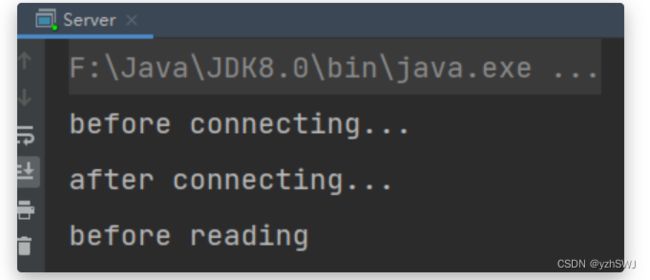
- 客户端发送数据后,服务器处理通道中的数据。再次进入循环时,再次被accept阻塞
- 之前的客户端再次发送消息,服务器端因为被accept阻塞,无法处理之前客户端发送到通道中的信息,accept只有建立新的连接才会继续执行,当有一个新的连接时,才会接收到之前客户端发送的消息,如果没有新的连接,线程会一直阻塞在accept
2、非阻塞
-
可以通过ServerSocketChannel的configureBlocking(false)方法将获得连接设置为非阻塞的。此时若没有连接,accept会返回null
-
可以通过SocketChannel的configureBlocking(false)方法将从通道中读取数据设置为非阻塞的。若此时通道中没有数据可读,read会返回-1
服务器代码如下
public class Server {
public static void main(String[] args) {
// 创建缓冲区
ByteBuffer buffer = ByteBuffer.allocate(16);
// 获得服务器通道
try {
ServerSocketChannel server = ServerSocketChannel.open()
// 为服务器通道绑定端口
server.bind(new InetSocketAddress(8080));
// 用户存放连接的集合
ArrayList channels = new ArrayList<>();
// 循环接收连接
while (true) {
// 设置为非阻塞模式,没有连接时返回null,不会阻塞线程
server.configureBlocking(false);
SocketChannel socketChannel = server.accept();
// 通道不为空时才将连接放入到集合中
if (socketChannel != null) {
System.out.println("after connecting...");
channels.add(socketChannel);
}
// 循环遍历集合中的连接
for(SocketChannel channel : channels) {
// 处理通道中的数据
// 设置为非阻塞模式,若通道中没有数据,会返回0,不会阻塞线程
channel.configureBlocking(false);
int read = channel.read(buffer);//没有数据,会返回0,不会阻塞线程
if(read > 0) {
buffer.flip();
ByteBufferUtil.debugRead(buffer);
buffer.clear();
System.out.println("after reading");
}
}
}
} catch (IOException e) {
e.printStackTrace();
}
}
} 这样写存在一个问题,因为设置为了非阻塞,会一直执行while(true)中的代码,CPU一直处于忙碌状态,会使得性能变低,所以实际情况中不使用这种方法处理请求
3、Selector
多路复用
单线程可以配合 Selector 完成对多个 Channel 可读写事件的监控,这称之为多路复用
- 多路复用仅针对网络 IO,普通文件 IO 无法利用多路复用
- 如果不用 Selector 的非阻塞模式,线程大部分时间都在做无用功,而 Selector 能够保证
- 有可连接事件时才去连接
- 有可读事件才去读取
- 有可写事件才去写入
- 限于网络传输能力,Channel 未必时时可写,一旦 Channel 可写,会触发 Selector 的可写事件
4、使用及Accept事件
要使用Selector实现多路复用,服务端代码如下改进
public class SelectServer {
public static void main(String[] args) {
ByteBuffer buffer = ByteBuffer.allocate(16);
// 获得服务器通道
try(ServerSocketChannel serverChannel = ServerSocketChannel.open()) {
serverChannel .bind(new InetSocketAddress(8080));
// 创建选择器
Selector selector = Selector.open();
// 通道必须设置为非阻塞模式
serverChannel.configureBlocking(false);
// 将通道注册到选择器中,并设置感兴趣的事件
//返回值是当前是事件 下面的 iterator.next();
serverChannel.register(selector, SelectionKey.OP_ACCEPT);
while (true) {
// 若没有事件就绪,线程会被阻塞,反之不会被阻塞。从而避免了CPU空转
// 返回值为就绪的事件个数
int ready = selector.select();
System.out.println("selector ready counts : " + ready);
// 获取所有事件
Set selectionKeys = selector.selectedKeys();
// 使用迭代器遍历事件
Iterator iterator = selectionKeys.iterator();
while (iterator.hasNext()) {
SelectionKey key = iterator.next();
// 判断key的类型
if(key.isAcceptable()) {
// 获得key对应的channel
ServerSocketChannel channel = (ServerSocketChannel) key.channel();
System.out.println("before accepting...");
// 获取连接并处理,而且是必须处理,否则需要取消,如果不处理 会一直循环
SocketChannel socketChannel = channel.accept();
System.out.println("after accepting...");
// 处理完毕后移除
iterator.remove();
}
}
}
} catch (IOException e) {
e.printStackTrace();
}
}
} 步骤解析
- 获得选择器Selector
Selector selector = Selector.open();
- 将通道设置为非阻塞模式,并注册到选择器中,并设置感兴趣的事件
- channel 必须工作在非阻塞模式
- FileChannel 没有非阻塞模式,因此不能配合 selector 一起使用
- 绑定的事件类型可以有
- connect - 客户端连接成功时触发
- accept - 服务器端成功接受连接时触发
- read - 数据可读入时触发,有因为接收能力弱,数据暂不能读入的情况
- write - 数据可写出时触发,有因为发送能力弱,数据暂不能写出的情况
// 通道必须设置为非阻塞模式 server.configureBlocking(false); // 将通道注册到选择器中,并设置感兴趣的实践 server.register(selector, SelectionKey.OP_ACCEPT);
-
通过Selector监听事件,并获得就绪的通道个数,若没有通道就绪,线程会被阻塞
-
阻塞直到绑定事件发生
int count = selector.select();Copy -
阻塞直到绑定事件发生,或是超时(时间单位为 ms)
int count = selector.select(long timeout);Copy -
不会阻塞,也就是不管有没有事件,立刻返回,自己根据返回值检查是否有事件
int count = selector.selectNow();
-
-
获取就绪事件并得到对应的通道,然后进行处理
// 获取所有事件
Set selectionKeys = selector.selectedKeys();
// 使用迭代器遍历事件
Iterator iterator = selectionKeys.iterator();
while (iterator.hasNext()) {
SelectionKey key = iterator.next();
// 判断key的类型,此处为Accept类型
if(key.isAcceptable()) {
// 获得key对应的channel
ServerSocketChannel channel = (ServerSocketChannel) key.channel();
// 获取连接并处理,而且是必须处理,否则需要取消
SocketChannel socketChannel = channel.accept();
// 处理完毕后移除
iterator.remove();
}
} 事件发生后能否不处理
事件发生后,要么处理,要么取消(cancel),不能什么都不做,否则下次该事件仍会触发,这是因为 nio 底层使用的是水平触发
5、Read事件
- 在Accept事件中,若有客户端与服务器端建立了连接,需要将其对应的SocketChannel设置为非阻塞,并注册到选择其中
- 添加Read事件,触发后进行读取操作
public class SelectServer {
public static void main(String[] args) {
ByteBuffer buffer = ByteBuffer.allocate(16);
// 获得服务器通道
try(ServerSocketChannel server = ServerSocketChannel.open()) {
server.bind(new InetSocketAddress(8080));
// 创建选择器
Selector selector = Selector.open();
// 通道必须设置为非阻塞模式
server.configureBlocking(false);
// 将通道注册到选择器中,并设置感兴趣的实践
server.register(selector, SelectionKey.OP_ACCEPT);
// 为serverKey设置感兴趣的事件
while (true) {
// 若没有事件就绪,线程会被阻塞,反之不会被阻塞。从而避免了CPU空转
// 返回值为就绪的事件个数
int ready = selector.select();
System.out.println("selector ready counts : " + ready);
// 获取所有事件
Set selectionKeys = selector.selectedKeys();
// 使用迭代器遍历事件
Iterator iterator = selectionKeys.iterator();
while (iterator.hasNext()) {
SelectionKey key = iterator.next();
// 判断key的类型
if(key.isAcceptable()) {
// 获得key对应的channel
ServerSocketChannel channel = (ServerSocketChannel) key.channel();
System.out.println("before accepting...");
// 获取连接
SocketChannel socketChannel = channel.accept();
System.out.println("after accepting...");
// 设置为非阻塞模式,同时将连接的通道也注册到选择其中
socketChannel.configureBlocking(false);
socketChannel.register(selector, SelectionKey.OP_READ);
// 处理完毕后移除
iterator.remove();
} else if (key.isReadable()) {
SocketChannel channel = (SocketChannel) key.channel();
System.out.println("before reading...");
channel.read(buffer);
System.out.println("after reading...");
buffer.flip();
ByteBufferUtil.debugRead(buffer);
buffer.clear();
// 处理完毕后移除
iterator.remove();
}
}
}
} catch (IOException e) {
e.printStackTrace();
}
}
} 删除事件
当处理完一个事件后,一定要调用迭代器的remove方法移除对应事件,否则会出现错误。原因如下
以我们上面的 Read事件 的代码为例
-
当调用了 server.register(selector, SelectionKey.OP_ACCEPT)后,Selector中维护了一个集合,用于存放SelectionKey以及其对应的通道
// WindowsSelectorImpl 中的 SelectionKeyImpl数组
private SelectionKeyImpl[] channelArray = new SelectionKeyImpl[8];
public class SelectionKeyImpl extends AbstractSelectionKey {
// Key对应的通道
final SelChImpl channel;
...
}
当选择器中的通道对应的事件发生后,selecionKey会被放到另一个集合中,但是selecionKey不会自动移除,所以需要我们在处理完一个事件后,通过迭代器手动移除其中的selecionKey。否则会导致已被处理过的事件再次被处理,就会引发错误
断开处理
当客户端与服务器之间的连接断开时,会给服务器端发送一个读事件,对异常断开和正常断开需要加以不同的方式进行处理
-
正常断开
-
正常断开时,服务器端的channel.read(buffer)方法的返回值为-1,所以当结束到返回值为-1时,需要调用key的cancel方法取消此事件,并在取消后移除该事件
-
int read = channel.read(buffer);
// 断开连接时,客户端会向服务器发送一个写事件,此时read的返回值为-1
if(read == -1) {
// 取消该事件的处理
key.cancel();
channel.close();
} else {
...
}
// 取消或者处理,都需要移除key
iterator.remove();-
异常断开
- 异常断开时,会抛出IOException异常, 在try-catch的catch块中捕获异常并调用key的cancel方法即可
消息边界
不处理消息边界存在的问题
将缓冲区的大小设置为4个字节,发送2个汉字(你好),通过decode解码并打印时,会出现乱码
ByteBuffer buffer = ByteBuffer.allocate(4);
// 解码并打印
System.out.println(StandardCharsets.UTF_8.decode(buffer));
你�
��这是因为UTF-8字符集下,1个汉字占用3个字节,此时缓冲区大小为4个字节,一次读时间无法处理完通道中的所有数据,所以一共会触发两次读事件。这就导致 你好 的 好 字被拆分为了前半部分和后半部分发送,解码时就会出现问题
处理消息边界
传输的文本可能有以下三种情况
- 文本大于缓冲区大小
- 此时需要将缓冲区进行扩容
- 发生半包现象
- 发生粘包现象
解决思路大致有以下三种
- 固定消息长度,数据包大小一样,服务器按预定长度读取,当发送的数据较少时,需要将数据进行填充,直到长度与消息规定长度一致。缺点是浪费带宽
- 另一种思路是按分隔符拆分,缺点是效率低,需要一个一个字符地去匹配分隔符
- TLV 格式,即 Type 类型、Length 长度、Value 数据(也就是在消息开头用一些空间存放后面数据的长度),如HTTP请求头中的Content-Type与Content-Length。类型和长度已知的情况下,就可以方便获取消息大小,分配合适的 buffer,缺点是 buffer 需要提前分配,如果内容过大,则影响 server 吞吐量
- Http 1.1 是 TLV 格式
- Http 2.0 是 LTV 格式
剩下文档直接跳网站 Netty学习之NIO基础 - Nyima's Blog
